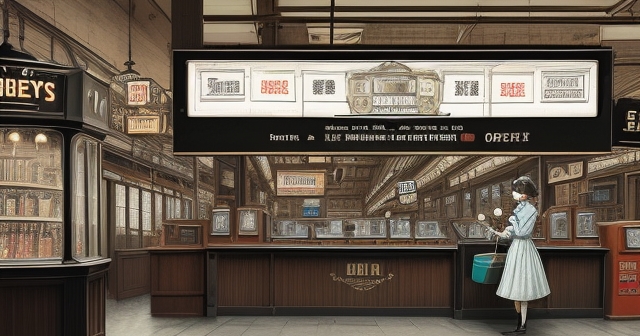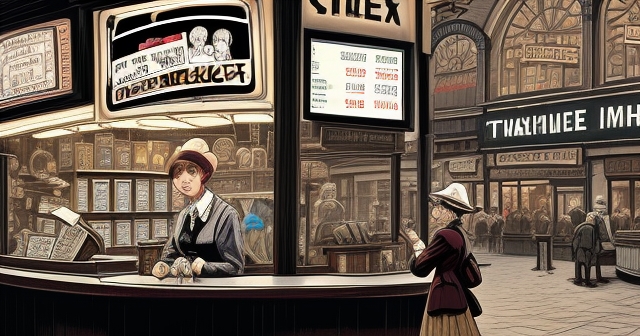Understanding the Shadow Market: A Deep Dive into Historical and Modern Bucket Shops
Have you ever wondered about the darker corners of financial history, places where the lines between investing and outright gambling blurred almost to invisibility? Today, we’re going to pull back the curtain on a fascinating, albeit troubling, phenomenon: the bucket shop. These entities, prevalent in a bygone era but with echoes in modern markets, represent a critical chapter in the evolution of financial regulation and investor protection. As you navigate the complexities of trading, understanding their history and recognizing their modern counterparts is crucial. We’ll explore what bucket shops were, how they operated, and why their story holds vital lessons for traders like you today.

At its core, a bucket shop wasn’t a legitimate brokerage firm in the sense we understand it today. Think of it less like an investment house and more like a bookmaker or gambling den. Instead of executing your buy or sell orders on a public exchange like the New York Stock Exchange (NYSE) or the Chicago Board of Trade, the bucket shop would take the opposite side of your trade internally. This practice, known as bucketing, meant they were effectively betting against you. Your profit was their loss, and their profit came directly from your loss.
- Bucket shops operated without regulatory oversight.
- They lured customers with promises of high returns.
- Many people lost substantial amounts of money to their deceptive practices.

Imagine you walked into a bucket shop and placed an order to buy shares of a certain stock because you believed its price would rise. A legitimate broker would send that order to the exchange to be matched with a seller. The bucket shop, however, wouldn’t. They would simply record your order in an internal ledger. If the stock price went up, and you wanted to sell for a profit, the bucket shop would have to pay you out of their own pocket. But if the price fell, and you decided to cut your losses or your position was automatically closed due to price movement, the money you put in (your initial margin or capital) became the bucket shop’s profit.
This inherent conflict of interest was the foundation of their business model. They didn’t earn commissions or fees for facilitating trades between buyers and sellers; they earned money when their clients lost. This incentivized them to see their clients fail. While they often mimicked the appearance of legitimate brokerages, complete with boards showing prices from the real exchanges, their internal operations were fundamentally different and predatory.

The assets they focused on were typically highly speculative and liquid, including not just securities (stocks and bonds) but also commodities like grain, cotton, and metals. The term “bucket shop” itself has debated origins. Some believe it came from small wheat dealers in the US who handled “bucketsful” of tiny, non-standard grain lots. Another theory suggests it stemmed from the practice of literally throwing trade tickets into a bucket and sorting them later, perhaps to allocate profitable trades to the house and losing ones to the clients.
| Aspect | Bucket Shop | Legitimate Brokerage |
|---|---|---|
| Execution | Internal matching | Sends orders to exchanges |
| Profit Model | Profits from customer losses | Earns commissions |
| Customer Protection | No regulation | Regulated |
The Rise Fueled by Technology and Public Demand
The late 19th and early 20th centuries were the golden age of the traditional bucket shop, flourishing particularly in Britain and the United States. What fueled their remarkable rise? Several factors converged to create fertile ground for these operations.
Firstly, there was immense public interest in the booming industrial economy and the financial markets. Ordinary people, not just wealthy elites, wanted to participate in the excitement and potential profits of speculation. However, access to legitimate exchanges like the NYSE required significant capital, often involving trading in large, standard blocks of shares or commodities (known as ’round lots’), which was beyond the reach of the average person.
- Bucket shops democratized speculation for the masses.
- They allowed for betting on price movements with smaller amounts of money.
- Their practices attracted a diverse clientele, including women.

Bucket shops democratized speculation, albeit in a fraudulent manner. They allowed people to bet on price movements with much smaller amounts of money, often on ‘odd lots’ (less than a round lot) or even fractions of shares. This opened the doors of speculative “investment” to the middle class, and notably, even attracted women at a time when their participation in formal financial markets was restricted or frowned upon. This accessibility contributed significantly to their popularity and widespread reach.
Secondly, and perhaps most crucially, the era saw revolutionary advancements in communication technology. The telegraph and, more specifically, the stock ticker were game changers. Before the ticker, real-time market prices were largely confined to the trading floors themselves or relayed slowly. The ticker tape transmitted price updates rapidly across cities and eventually across the country, bringing the pulse of Wall Street to main streets and back offices.
| Technology | Impact on Trading |
|---|---|
| Telegraph | Fast communication of prices |
| Stock Ticker | Real-time price updates |
| Ticker Tape | Brought market data to the public |
Bucket shops capitalized on this. They would receive the ticker feed and display these real-time prices on boards in their establishments, mimicking legitimate brokers. Clients could watch the prices tick by and place bets based on these movements. The technology provided the illusion of participating directly in the market, even though their trades were never actually sent to an exchange. This new, readily available data fueled what contemporaries called “tickeritis” – an almost addictive compulsion to watch the ticker tape and speculate, which was even discussed in medical journals as a form of nervous disorder. It highlighted the psychological pull of constant market data, a theme that, as we’ll see, resonates strongly today.
The scale of their operation was staggering. By 1889, it’s estimated that the volume of wagers placed in bucket shops in the US alone exceeded the actual trading volume on the NYSE by seven times. This gives you a sense of just how pervasive this “shadow market” or “financial netherworld” had become, operating parallel to but separate from the official exchanges and highlighting the immense public appetite for speculative activity.

The proliferation of bucket shops created a significant crisis of legitimacy for established financial institutions, particularly Wall Street. Here were operations that looked, on the surface, very similar to legitimate brokerage houses – they had offices, price boards, clerks taking orders. They used the same language of buying and selling, stocks and commodities. But their underlying mechanism was fundamentally different and based on a conflict of interest.
This blurring of lines made it difficult for the public to distinguish between legitimate speculation and outright gambling or, worse, a confidence trick designed to fleece unsuspecting individuals. The established financial industry felt its reputation was being tarnished by association. They saw bucket shops not just as illegal competitors but as a threat to the very idea of finance as a rational, productive economic activity. Instead, bucket shops reinforced a public perception of markets as rigged casinos.
| Issue | Effect on Market |
|---|---|
| Reputation Damage | Tarnished public perception of finance |
| Confusion | Blurred lines between speculation and gambling |
| Exploitation | Vulnerable clients were often taken advantage of |
To combat this, the legitimate industry began to actively differentiate itself. They emphasized themes of professionalism, expertise, and the sober, rational analysis of market fundamentals. This narrative often contrasted the calm, considered approach of the “professional investor” with the amateur “hysteria” or “gambling fever” associated with bucket shop patrons glued to the ticker tape. There was even a gendered element to this, with legitimate finance portraying itself as a masculine domain of reason, distinct from the emotional, supposedly less disciplined world of amateur speculation that bucket shops facilitated, which, as noted, included female clients.
Furthermore, bucket shops weren’t just passive bookmakers; they often actively exploited their clients. Since they held orders internally, they knew exactly what their clients were betting on. This knowledge, combined with the lack of regulation, allowed for various manipulative tactics:
- Manipulating Local Prices: While they couldn’t typically move the prices on the major exchanges, a large or concentrated position among their clients might incentivize them to use tactics like “wash sales” (simultaneous buying and selling by the same party to create artificial volume or price movement) in local markets to trigger client stop-losses or margins calls, thus closing client positions at a loss to the client and a gain for the house.
- Delayed or Faked Ticker Feeds: In some cases, less scrupulous bucket shops might slightly delay their ticker feeds or even display fabricated prices to mislead clients and encourage trading decisions that would benefit the house.
- Exploiting Information Asymmetry: In an era where insider trading was not yet illegal, bucket shops operated within a financial system ripe for manipulation by powerful players. Inexperienced investors, often referred to as “lambs” being led to the slaughter, were particularly vulnerable to exploitation in this environment.
This period starkly highlighted the dangers of unregulated financial markets and the need for transparency and rules that protect individual investors from those with inherent conflicts of interest.
Regulatory Crackdown and the Demise of the Traditional Bucket Shop
The rampant growth and fraudulent nature of bucket shops could not continue unchecked forever. As their negative impact on public perception, market legitimacy, and individual investors became undeniable, calls for regulation grew louder. The journey from a largely unregulated financial landscape to one with investor protection was long and hard-fought, but the bucket shop phenomenon played a significant role in driving this change.
Early attempts at control were often piecemeal and insufficient. However, the financial crises and market crashes of the late 19th and early 20th centuries, coupled with high-profile cases of fraud and manipulation (often involving tactics similar to or enabled by the ‘shadow market’ bucket shops represented), built momentum for comprehensive reform. The Great Depression and the subsequent collapse of the stock market in 1929 served as a major catalyst.
The most significant legislative response came with the passage of the Securities Exchange Act of 1934 in the United States. This landmark legislation created the Securities and Exchange Commission (SEC) and laid the foundation for much of modern US securities regulation. Crucially, the Act made traditional bucketing illegal. It mandated that brokerage firms must execute client orders on a regulated exchange or market, rather than holding them internally and betting against the client.
The Act also introduced rules designed to prevent bucketing and increase transparency. For instance, it required brokers to send clients confirmation slips detailing the price and time of the trade, and the exchange where it was executed. This created a verifiable record that the trade had actually occurred on an external market, making it much harder for firms to simply pocket client funds without trading. While sophisticated fraudsters could still attempt to circumvent rules, these regulations established a legal framework and regulatory oversight aimed squarely at eliminating the core bucket shop practice.
Simultaneously, increased market sophistication, better access to legitimate brokerage services (as minimum requirements evolved or new types of firms emerged), and greater public awareness also contributed to the decline of the traditional, physical bucket shop. The opaque, high-risk model became less viable as legitimate markets became more accessible and regulated. The ‘shadow market’ of the late 19th century gradually receded as regulatory bodies gained power and enforced stricter rules.
Lessons for Today: Modern Echoes and Protecting Yourself
While the physical bucket shop of the ticker tape era is largely gone, the underlying principle – a broker profiting directly from client losses due to a conflict of interest – hasn’t entirely disappeared. The term “bucket shop” is still used today, often to describe online brokerage firms or trading platforms that engage in similar deceptive or fraudulent practices, preying on inexperienced traders in rapidly moving markets like Forex, CFDs, and, historically, parts of the less-regulated cryptocurrency space.
How might this manifest in the modern era? Instead of a physical board, it’s an online trading platform. Instead of a telegraph, it’s high-speed internet and mobile apps. But the tactics can share alarming similarities:
- Non-Execution or Internal Matching: Some unscrupulous platforms might not send your trades to the interbank market or a legitimate exchange. Instead, they might match client orders internally or simply take the other side of the trade, especially with instruments like CFDs or Forex, where the broker can act as a market maker. While legitimate market making involves managing risk and facilitating client trades, a bucket shop-like model uses it to guarantee client losses.
- Price Manipulation: Minor ‘slippage’ or unfavorable price fills could be attributed to market volatility, but in a modern bucket shop, prices might be deliberately manipulated slightly to trigger stop losses or margin calls on their clients’ positions, benefiting the house.
- Excessive Leverage & Aggressive Tactics: Offering exorbitant leverage can quickly wipe out a trader’s capital with small price movements, guaranteeing losses for the client. High-pressure sales tactics or pushing clients into overly risky strategies also align with the bucket shop goal of maximizing client losses.
- Lack of Transparency and Poor Execution: Opaque fees, confusing terms, and unusually poor trade execution quality can be red flags.
The historical lessons from the bucket shop era are incredibly relevant today, especially in less regulated or fast-evolving financial spaces. The GameStop saga, for instance, while different in mechanics, highlighted the power dynamics between amateur investors and established financial players and sparked debates about market structure and fairness – echoes of the legitimacy crisis bucket shops posed to Wall Street. The collapse of major entities in the crypto space, like FTX, further underscores the critical need for robust regulation, transparency, and investor protection mechanisms, mirroring the regulatory void that allowed historical bucket shops to thrive.
For you, as an investor or trader, recognizing the signs of a potentially unethical broker operating like a modern bucket shop is vital:
- Lack of Regulation: Is the firm regulated by reputable financial authorities (like the SEC, FCA, ASIC, FSCA)? If not, be extremely wary.
- Guaranteed Profits: No legitimate firm can guarantee trading profits. This is a classic scam tactic.
- Aggressive Sales Pressure: Legitimate brokers don’t typically hound you to deposit more money or make specific trades.
- Unusual Fees or Terms: Read the fine print carefully. High, hidden fees or terms that seem stacked against you are warning signs.
- Difficulty Withdrawing Funds: This is a major red flag for any scam operation.
Due diligence is your first line of defense. Verify a broker’s regulatory status, read reviews (but be critical of fake ones), and start with small amounts if you are unsure. Understanding that a broker’s business model should be based on facilitating your trades on real markets, not betting against you, is fundamental.
If you are considering exploring CFDs or Forex trading, choosing a platform with strong regulatory oversight is non-negotiable. Look for brokers licensed in multiple reputable jurisdictions, offering clear terms, transparent pricing, and robust technology that ensures genuine market access and reliable execution. The historical experience with bucket shops teaches us that trusting your capital to unregulated or opaque entities is a gamble stacked against you from the start.
If you’re considering starting Forex trading or exploring more CFD products, Moneta Markets is a platform worth considering. Based in Australia, it offers over 1000 financial instruments, catering to both beginners and professional traders.
In choosing a trading platform, Moneta Markets‘ flexibility and technological advantages are noteworthy. It supports mainstream platforms like MT4, MT5, and Pro Trader, combined with high-speed execution and low spread settings, providing a good trading experience.
The Ongoing Struggle for Market Integrity
The story of bucket shops is more than just a historical footnote; it’s a vivid illustration of the constant tension between innovation, speculation, and the need for robust regulation to protect investors and maintain market integrity. The technologies changed, from the ticker tape to mobile apps, but the potential for exploitation based on information asymmetry and conflicts of interest persists.
The fight against fraudulent practices and shadow markets is ongoing. Regulators around the world continue to adapt to new financial products and platforms. Events like the FTX collapse highlight the importance of expanding regulatory frameworks to cover novel asset classes and business models that can, intentionally or unintentionally, replicate the risks seen in the past.
For us, as participants in today’s financial markets, the key takeaway from the bucket shop era is clear: vigilance is paramount. Understand how your broker makes money, ensure they are properly regulated, and be skeptical of anything that sounds too good to be true, promises guaranteed returns, or pressures you into risky behavior. The lessons learned from the “financial netherworld” of over a century ago remain incredibly relevant in the interconnected, digital markets we trade in today.
By understanding the historical context and the evolution of financial regulation in response to entities like bucket shops, you equip yourself with the knowledge needed to navigate the modern market landscape safely and confidently, distinguishing legitimate opportunities from potential pitfalls. The goal, ultimately, is to ensure that your participation in the market is based on informed decisions and fair practices, not on unknowingly betting against a house that’s rigged to win.
bucket shopsFAQ
Q:What are bucket shops?
A:Bucket shops are fraudulent trading venues where brokers profit from client losses by not executing trades on legitimate exchanges.
Q:How did bucket shops operate historically?
A:They took orders without sending them to exchanges, betting internally against clients, leading to conflicts of interest and high client losses.
Q:What regulations were introduced to combat bucket shops?
A:The Securities Exchange Act of 1934 prohibited bucketing and established the SEC for investor protection and market integrity.
